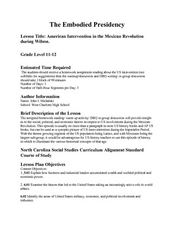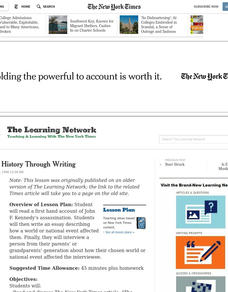Curated OER
Unit 2: Post-Revolution: The Critical Period 1781-1878
The post-Revolutionary Period of 1781-1787, also known as the Critical Period, is the focus of a series of lessons that prompt class members to examine primary source documents that reveal the instability of the period of the Articles of...
Curated OER
Westward Expansion (1807-1912)
In this online interactive history worksheet, students respond to 10 short answer and essay questions about the Westward Expansion in the United States. Students may check some of their answers on the interactive worksheet.
Curated OER
The Embodied Presidency Wilson
Young scholars take a closer look at U.S. intervention in Mexico. In this 20th century history lesson, students examine primary documents to consider why the United States entered the Mexican War and then write DBQ essays on the topic.
Shmoop
ELA.CCSS.ELA-Literacy.SL.11-12.3
Dr. Martin Luther King Jr.'s speech, "I Have a Dream," is one of the most famous in United States history, but why was it so effective? Ask your class to determine the answer to this question. While the resource includes a description of...
Echoes & Reflections
The "Final Solution"
Nazi policies shifted from deportation and imprisonment to extermination of the Jewish people in death camps in the "Final Solution." Learners examine photos of artifacts, read poetry written by survivors, analyze testimony from...
Curated OER
Famous People and Cultural Diffusion
Students use the internet to identify cultural traditions throughout the world. In groups, they examine each culture and determine the effect they had on life in the United States. They use this information to write a family history...
Curated OER
Building the State (1781-1797)
In this online interactive history instructional activity, students respond to 9 short answer and essay questions about the vision of the Republicans and the Federalists.
Curated OER
Reliving History Through Writing
Students read a first hand account of John F. Kennedy's assassination. They write an essay describing how a world or national event affected them.
Curated OER
Country Project
Students research any part of the United States that they want to know more about. This may include the culture, food or people. They have to present their information to the class, display a visual aid and write a paper on the...
US DBQs European Migration through Civil War
This activity contains DBQs about United States History ranging from the European Migration through the Civil War. All of the documents provided contain primary sources for students to answer as well as an essay to complete once...
US DBQs Reconstruction to Today
This activity contains DBQs about United States History ranging from Reconstruction to Present Day. All of the documents provided contain primary sources for students to answer as well as an essay to complete once documents are complete.
Curated OER
Leaders, Laborers, and Other Perspectives of World War II
How did the women in France feel about their country’s involvement in World War II? Class groups are assigned a country involved in WWII, and individuals within the group adopt the point of view of leaders, laborers, businessmen, women,...
US House of Representatives
Keeping the Faith: African Americans Return to Congress, 1929–1970
The third lesson in a unit that traces the history of African Americans serving in the US Congress examines the period from 1929 through 1970. After reading a contextual essay that details the few African Americans elected to Congress...
US House of Representatives
“The Fifteenth Amendment in Flesh and Blood,” The Symbolic Generation of Black Americans in Congress, 1870–1887
The reading of a contextual essay launches a study of Black Americans who served in Congress from 1870 through 1887. Young historians identify the African Americans who served during this period, investigate the ways they won national...
American Battlefield Trust
Contrasting the North and South Before the War
Fundamental differences between the North and South led to the South adopting a system of enslaved labor. These abstract ideas become concrete when class members create a standing cube using information provided in the resource. Young...
US House of Representatives
Exclusion and Empire, 1898–1941
Often forgotten and written off as the model minority, Americans with heritage in Asia and the Pacific Islands have played an essential role in American history, including Congress. Budding historians reclaim history by researching the...
American Battlefield Trust
Southern Secession and Abraham Lincoln’s Presidential Election
President Abraham Lincoln: a true humanitarian or a savvy politician? The lesson focuses on Abraham Lincoln's presidency and the secession of the southern states. Academics interpret how Lincoln's presidential platform promoting African...
Center for History Education
Where Did Thomas Jefferson Stand on the Issue of Slavery?
Thomas Jefferson was a complicated man with a complex legacy. Middle schoolers examine a series of primary source documents to gather evidence for an essay in which they answer where Jefferson stood on the issue of slavery.
US House of Representatives
“‘The Negroes’ Temporary Farewell,” Jim Crow and the Exclusion of African Americans from Congress, 1887–1929
Despite some advances made during the Reconstruction Era following the Civil War, the period from 1887 through 1929, African Americans serving in Congress suffered severe setbacks due to Jim Crow Laws and voter suppression. Class members...
Curated OER
Migration and Immigration in the United States: Three Case Studies
Students examine the early migration of Native Americans, African Americans, and the British Colonists. They conduct Internet research, complete a timeline, label maps, compare/contrast the three groups' experiences, and write an essay.
Curated OER
Will You Pick My Cotton?
Use this cross-curricular history lesson to work on your students' informational writing skills. After listening to songs and stories related to Sultana, they engage in a several activities to boost their understanding of slavery and...
Curated OER
The Civil War: A Nation Divided
Discuss the differences between the North and the South and how those differences led to the Civil War. Middle schoolers examine and analyze a famous speech or writing by President Lincoln in order to better understand the speaker's...
Curated OER
Book: Latino Economics in the United States: Job Diversity
Learners, after reading Chapter 1 in the book, "Latino Economics in the United States: Job Diversity," write an essay that compares the cultural as well as the historical factors (experiences with jobs, discrimination, education, etc.)...
Curated OER
Timeline - United States and Germany, Before, During, and After World War II
Students read novel Rosa's Miracle Mouse, research assigned years in small groups, and create timelines and Powerpoint presentations detailing interaction between Germany and the United States before, during, and after World War II.

























